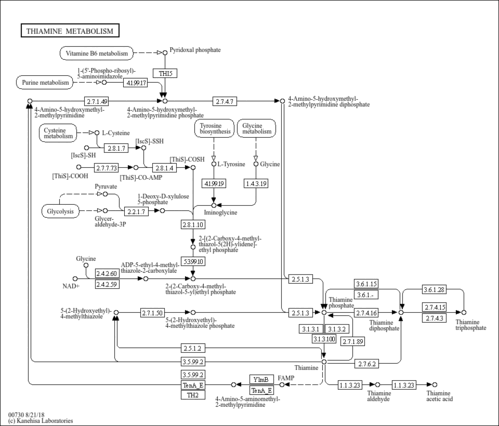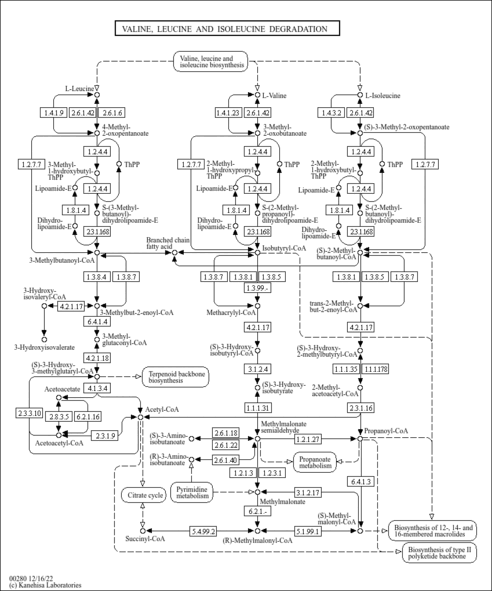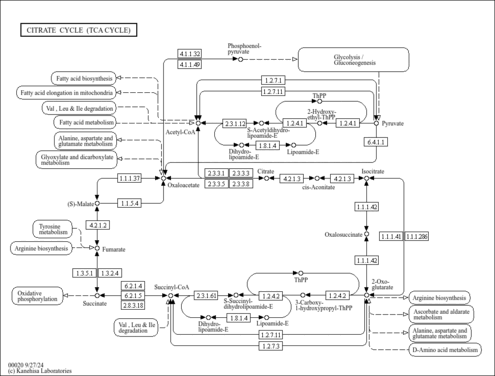| Record Information |
|---|
| Version | 1.0 |
|---|
| Created at | 2020-04-17 18:49:18 UTC |
|---|
| Updated at | 2020-11-18 16:38:58 UTC |
|---|
| CannabisDB ID | CDB004908 |
|---|
| Secondary Accession Numbers | Not Available |
|---|
| Cannabis Compound Identification |
|---|
| Common Name | Thiamine pyrophosphate |
|---|
| Description | Thiamine pyrophosphate, also known as thiamin diphosphoric acid or THPP, belongs to the class of organic compounds known as thiamine phosphates. These are thiamine derivatives in which the hydroxyl group of the ethanol moiety is substituted by a phosphate group. A 1,3-thiazolium cation that is the conjugate acid of thiamine(1+) diphosphate(1). Thiamine pyrophosphate is a very strong basic compound (based on its pKa). Thiamine pyrophosphate exists in all living species, ranging from bacteria to humans. Within humans, thiamine pyrophosphate participates in a number of enzymatic reactions. In particular, S-(2-methylbutanoyl)-dihydrolipoamide and thiamine pyrophosphate can be biosynthesized from lipoamide and 2-methyl-1-hydroxypropyl-THPP through the action of the enzymes 2-oxoisovalerate dehydrogenase subunit alpha, mitochondrial and 2-oxoisovalerate dehydrogenase subunit beta, mitochondrial. In addition, ketoleucine and thiamine pyrophosphate can be converted into 3-methyl-1-hydroxybutyl-THPP; which is catalyzed by the enzyme 2-oxoisovalerate dehydrogenase. In humans, thiamine pyrophosphate is involved in the metabolic disorder called the 2-methyl-3-hydroxybutyryl-coa dehydrogenase deficiency pathway. Thiamine pyrophosphate is expected to be in Cannabis as all living plants are known to produce and metabolize it. |
|---|
| Structure | |
|---|
| Synonyms | | Value | Source |
|---|
| Thiamin diphosphate | ChEBI | | Thiamin pyrophosphate | ChEBI | | Thiamine diphosphate | ChEBI | | THPP | ChEBI | | TPP | ChEBI | | Thiamin diphosphoric acid | Generator | | Thiamin pyrophosphoric acid | Generator | | Thiamine diphosphoric acid | Generator | | Thiamine pyrophosphoric acid | Generator | | Thaimine pyrophosphate | HMDB | | Thiamin-ppi | HMDB | | Thiamine-ppi | HMDB | | Thiamine-pyrophosphate | HMDB | | Cocarboxylase | HMDB | | Berolase | HMDB | | Pyrophosphate, thiamine | HMDB |
|
|---|
| Chemical Formula | C12H19N4O7P2S |
|---|
| Average Molecular Weight | 425.31 |
|---|
| Monoisotopic Molecular Weight | 425.045 |
|---|
| IUPAC Name | 3-[(4-amino-2-methylpyrimidin-5-yl)methyl]-5-(2-{[hydroxy(phosphonooxy)phosphoryl]oxy}ethyl)-4-methyl-1,3-thiazol-3-ium |
|---|
| Traditional Name | thiamin pyrophosphate |
|---|
| CAS Registry Number | 136-09-4 |
|---|
| SMILES | CC1=C(CCOP(O)(=O)OP(O)(O)=O)SC=[N+]1CC1=CN=C(C)N=C1N |
|---|
| InChI Identifier | InChI=1S/C12H18N4O7P2S/c1-8-11(3-4-22-25(20,21)23-24(17,18)19)26-7-16(8)6-10-5-14-9(2)15-12(10)13/h5,7H,3-4,6H2,1-2H3,(H4-,13,14,15,17,18,19,20,21)/p+1 |
|---|
| InChI Key | AYEKOFBPNLCAJY-UHFFFAOYSA-O |
|---|
| Chemical Taxonomy |
|---|
| Description | Belongs to the class of organic compounds known as thiamine phosphates. These are thiamine derivatives in which the hydroxyl group of the ethanol moiety is substituted by a phosphate group. |
|---|
| Kingdom | Organic compounds |
|---|
| Super Class | Organoheterocyclic compounds |
|---|
| Class | Diazines |
|---|
| Sub Class | Pyrimidines and pyrimidine derivatives |
|---|
| Direct Parent | Thiamine phosphates |
|---|
| Alternative Parents | |
|---|
| Substituents | - Thiamine-phosphate
- Organic pyrophosphate
- 4,5-disubstituted 1,3-thiazole
- Monoalkyl phosphate
- Hydropyrimidine
- Organic phosphoric acid derivative
- Phosphoric acid ester
- Alkyl phosphate
- Imidolactam
- Thiazole
- Azole
- Heteroaromatic compound
- Azacycle
- Organic oxide
- Organic nitrogen compound
- Organopnictogen compound
- Organooxygen compound
- Organonitrogen compound
- Organic oxygen compound
- Hydrocarbon derivative
- Organic cation
- Aromatic heteromonocyclic compound
|
|---|
| Molecular Framework | Aromatic heteromonocyclic compounds |
|---|
| External Descriptors | |
|---|
| Ontology |
|---|
|
| Physiological effect | Health effect: |
|---|
| Disposition | Source: Biological location: |
|---|
| Physical Properties |
|---|
| State | Solid |
|---|
| Experimental Properties | | Property | Value | Reference |
|---|
| Melting Point | Not Available | Not Available | | Boiling Point | Not Available | Not Available | | Water Solubility | Not Available | Not Available | | logP | Not Available | Not Available |
|
|---|
| Predicted Properties | [] |
|---|
| Spectra |
|---|
| EI-MS/GC-MS | | Type | Description | Splash Key | View |
|---|
| Predicted GC-MS | Thiamine pyrophosphate, non-derivatized, Predicted GC-MS Spectrum - 70eV, Positive | splash10-002b-9734000000-83738512818790cf1cc5 | Spectrum | | Predicted GC-MS | Thiamine pyrophosphate, non-derivatized, Predicted GC-MS Spectrum - 70eV, Positive | Not Available | Spectrum |
|
|---|
| MS/MS | | Type | Description | Splash Key | View |
|---|
| MS/MS | LC-MS/MS Spectrum - Quattro_QQQ 10V, Positive (Annotated) | splash10-004i-0201900000-9ca110d3800e4ebfad43 | 2012-07-24 | View Spectrum | | MS/MS | LC-MS/MS Spectrum - Quattro_QQQ 25V, Positive (Annotated) | splash10-00di-0900000000-dad8835a4b26b1df86c4 | 2012-07-24 | View Spectrum | | MS/MS | LC-MS/MS Spectrum - Quattro_QQQ 40V, Positive (Annotated) | splash10-00di-2900000000-83b0eb52fe05e7097aff | 2012-07-24 | View Spectrum | | MS/MS | LC-MS/MS Spectrum - LC-ESI-QQ (API3000, Applied Biosystems) 10V, Negative | splash10-00di-0000900000-538ee08c2fc9a905eaad | 2012-08-31 | View Spectrum | | MS/MS | LC-MS/MS Spectrum - LC-ESI-QQ (API3000, Applied Biosystems) 20V, Negative | splash10-0udi-0309000000-b196fd5684e86907d04e | 2012-08-31 | View Spectrum | | MS/MS | LC-MS/MS Spectrum - LC-ESI-QQ (API3000, Applied Biosystems) 30V, Negative | splash10-0udi-0409000000-088cf88d5056ce245770 | 2012-08-31 | View Spectrum | | MS/MS | LC-MS/MS Spectrum - LC-ESI-QQ (API3000, Applied Biosystems) 40V, Negative | splash10-004i-9822000000-011b97ebb9fdcebffc93 | 2012-08-31 | View Spectrum | | MS/MS | LC-MS/MS Spectrum - LC-ESI-QQ (API3000, Applied Biosystems) 50V, Negative | splash10-004i-9200000000-2ecd5ee7eb283c5cd990 | 2012-08-31 | View Spectrum | | MS/MS | LC-MS/MS Spectrum - LC-ESI-QQ (API3000, Applied Biosystems) 10V, Positive | splash10-004i-0001900000-59ea8d394aed62700202 | 2012-08-31 | View Spectrum | | MS/MS | LC-MS/MS Spectrum - LC-ESI-QQ (API3000, Applied Biosystems) 20V, Positive | splash10-00b9-0614900000-08f09a377f03019f4457 | 2012-08-31 | View Spectrum | | MS/MS | LC-MS/MS Spectrum - LC-ESI-QQ (API3000, Applied Biosystems) 30V, Positive | splash10-00di-0911000000-de2b56b98b01c6409b09 | 2012-08-31 | View Spectrum | | MS/MS | LC-MS/MS Spectrum - LC-ESI-QQ (API3000, Applied Biosystems) 40V, Positive | splash10-00di-0900000000-7d75ca5105912446e47b | 2012-08-31 | View Spectrum | | MS/MS | LC-MS/MS Spectrum - LC-ESI-QQ (API3000, Applied Biosystems) 50V, Positive | splash10-00di-2900000000-d632b8688f17a7a01de0 | 2012-08-31 | View Spectrum | | MS/MS | LC-MS/MS Spectrum - LC-ESI-QQ , negative | splash10-00di-0000900000-538ee08c2fc9a905eaad | 2017-09-14 | View Spectrum | | MS/MS | LC-MS/MS Spectrum - LC-ESI-QQ , negative | splash10-0udi-0309000000-b196fd5684e86907d04e | 2017-09-14 | View Spectrum | | MS/MS | LC-MS/MS Spectrum - LC-ESI-QQ , negative | splash10-0udi-0409000000-088cf88d5056ce245770 | 2017-09-14 | View Spectrum | | MS/MS | LC-MS/MS Spectrum - LC-ESI-QQ , negative | splash10-004i-9822000000-670f784e69ef56047333 | 2017-09-14 | View Spectrum | | MS/MS | LC-MS/MS Spectrum - LC-ESI-QQ , negative | splash10-004i-9200000000-2ecd5ee7eb283c5cd990 | 2017-09-14 | View Spectrum | | MS/MS | LC-MS/MS Spectrum - LC-ESI-QQ , positive | splash10-004i-0001900000-59ea8d394aed62700202 | 2017-09-14 | View Spectrum | | Predicted MS/MS | Predicted LC-MS/MS Spectrum - 10V, Positive | splash10-004i-0100900000-2d5d6c77c0c7e2d2d28a | 2016-09-12 | View Spectrum | | Predicted MS/MS | Predicted LC-MS/MS Spectrum - 20V, Positive | splash10-0aba-8146900000-e4efbc495cf0eb380395 | 2016-09-12 | View Spectrum | | Predicted MS/MS | Predicted LC-MS/MS Spectrum - 40V, Positive | splash10-0a4j-4911100000-7e4a6eda3f297e8051b7 | 2016-09-12 | View Spectrum | | Predicted MS/MS | Predicted LC-MS/MS Spectrum - 10V, Negative | splash10-00di-0000900000-08198f6dfeaa404b8b0f | 2016-09-12 | View Spectrum | | Predicted MS/MS | Predicted LC-MS/MS Spectrum - 20V, Negative | splash10-001i-9100200000-2d9e7e5d87267ce83dcc | 2016-09-12 | View Spectrum | | Predicted MS/MS | Predicted LC-MS/MS Spectrum - 40V, Negative | splash10-004j-9200000000-a470e5de9f124c159e0e | 2016-09-12 | View Spectrum |
|
|---|
| NMR | | Type | Description | | View |
|---|
| 1D NMR | 1H NMR Spectrum (1D, 600 MHz, H2O, experimental) | | Spectrum | | 1D NMR | 1H NMR Spectrum (1D, 100 MHz, D2O, predicted) | | Spectrum | | 1D NMR | 13C NMR Spectrum (1D, 100 MHz, D2O, predicted) | | Spectrum | | 1D NMR | 1H NMR Spectrum (1D, 1000 MHz, D2O, predicted) | | Spectrum | | 1D NMR | 13C NMR Spectrum (1D, 1000 MHz, D2O, predicted) | | Spectrum | | 1D NMR | 1H NMR Spectrum (1D, 200 MHz, D2O, predicted) | | Spectrum | | 1D NMR | 13C NMR Spectrum (1D, 200 MHz, D2O, predicted) | | Spectrum | | 1D NMR | 1H NMR Spectrum (1D, 300 MHz, D2O, predicted) | | Spectrum | | 1D NMR | 13C NMR Spectrum (1D, 300 MHz, D2O, predicted) | | Spectrum | | 1D NMR | 1H NMR Spectrum (1D, 400 MHz, D2O, predicted) | | Spectrum | | 1D NMR | 13C NMR Spectrum (1D, 400 MHz, D2O, predicted) | | Spectrum | | 1D NMR | 1H NMR Spectrum (1D, 500 MHz, D2O, predicted) | | Spectrum | | 1D NMR | 13C NMR Spectrum (1D, 500 MHz, D2O, predicted) | | Spectrum | | 1D NMR | 1H NMR Spectrum (1D, 600 MHz, D2O, predicted) | | Spectrum | | 1D NMR | 13C NMR Spectrum (1D, 600 MHz, D2O, predicted) | | Spectrum | | 1D NMR | 1H NMR Spectrum (1D, 700 MHz, D2O, predicted) | | Spectrum | | 1D NMR | 13C NMR Spectrum (1D, 700 MHz, D2O, predicted) | | Spectrum | | 1D NMR | 1H NMR Spectrum (1D, 800 MHz, D2O, predicted) | | Spectrum | | 1D NMR | 13C NMR Spectrum (1D, 800 MHz, D2O, predicted) | | Spectrum | | 1D NMR | 1H NMR Spectrum (1D, 900 MHz, D2O, predicted) | | Spectrum | | 1D NMR | 13C NMR Spectrum (1D, 900 MHz, D2O, predicted) | | Spectrum | | 1D NMR | 1H NMR Spectrum (1D, 600 MHz, H2O, experimental) | | Spectrum | | 1D NMR | 1H NMR Spectrum (1D, 600 MHz, H2O, experimental) | | Spectrum | | 2D NMR | [1H, 13C]-HSQC NMR Spectrum (2D, 600 MHz, H2O, experimental) | | Spectrum |
|
|---|
| Pathways |
|---|
| Pathways | | Name | SMPDB/Pathwhiz | KEGG | | Thiamine Metabolism |    |  | | Valine, Leucine and Isoleucine Degradation |    |  | | Citric Acid Cycle |    |  | | Congenital lactic acidosis |    | Not Available | | Fumarase deficiency |    | Not Available |
|
|---|
| Protein Targets |
|---|
| Enzymes | |
| Pyruvate dehydrogenase E1 component subunit beta, mitochondrial | PDHB | 3p21.1-p14.2 | P11177 | details | | Pyruvate dehydrogenase E1 component subunit alpha, somatic form, mitochondrial | PDHA1 | Xp22.1 | P08559 | details | | Pyruvate dehydrogenase E1 component subunit alpha, testis-specific form, mitochondrial | PDHA2 | 4q22-q23 | P29803 | details | | 2-oxoisovalerate dehydrogenase subunit beta, mitochondrial | BCKDHB | 6q14.1 | P21953 | details | | 2-oxoisovalerate dehydrogenase subunit alpha, mitochondrial | BCKDHA | 19q13.1-q13.2 | P12694 | details | | 2-oxoglutarate dehydrogenase, mitochondrial | OGDH | 7p14-p13 | Q02218 | details | | Thiamin pyrophosphokinase 1 | TPK1 | 7q34-q35 | Q9H3S4 | details | | Transketolase-like protein 1 | TKTL1 | Xq28 | P51854 | details | | Transketolase | TKT | 3p14.3 | P29401 | details | | Ectonucleoside triphosphate diphosphohydrolase 5 | ENTPD5 | 14q24 | O75356 | details | | Thiamine-triphosphatase | THTPA | 14q11.2 | Q9BU02 | details | | Transketolase-like protein 2 | TKTL2 | 4q32.2 | Q9H0I9 | details | | Acetolactate synthase-like protein | ILVBL | 19p13.1 | A1L0T0 | details | | 2-hydroxyacyl-CoA lyase 1 | HACL1 | 3p25.1 | Q9UJ83 | details | | Probable 2-oxoglutarate dehydrogenase E1 component DHKTD1, mitochondrial | DHTKD1 | 10p14 | Q96HY7 | details | | 2-oxoglutarate dehydrogenase-like, mitochondrial | OGDHL | | Q9ULD0 | details | | Cancer-related nucleoside-triphosphatase | NTPCR | 1q42.2 | Q9BSD7 | details |
|
|---|
| Transporters | Not Available |
|---|
| Metal Bindings | |
|---|
| Receptors | Not Available |
|---|
| Transcriptional Factors | Not Available |
|---|
| Concentrations Data |
|---|
| Not Available |
|---|
| External Links |
|---|
| HMDB ID | HMDB0001372 |
|---|
| DrugBank ID | DB01987 |
|---|
| Phenol Explorer Compound ID | Not Available |
|---|
| FoodDB ID | FDB022584 |
|---|
| KNApSAcK ID | C00019627 |
|---|
| Chemspider ID | 1100 |
|---|
| KEGG Compound ID | C00068 |
|---|
| BioCyc ID | THIAMINE-PYROPHOSPHATE |
|---|
| BiGG ID | 33732 |
|---|
| Wikipedia Link | Thiamine pyrophosphate |
|---|
| METLIN ID | 2832 |
|---|
| PubChem Compound | 1132 |
|---|
| PDB ID | TDP |
|---|
| ChEBI ID | 9532 |
|---|
| References |
|---|
| General References | Not Available |
|---|


